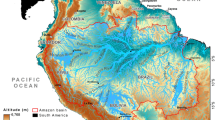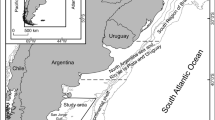Abstract
Fisheries statistics available from the River Elbe catchment since the middle of the 16th century onwards have been compiled and analyzed to assess 1. the spatial distribution and patterns of returning salmon, 2. the total abundance of the salmon stock, as well as 3. local impacts, reasons, and time lags of salmon decline. Catch data and fisheries statistics of up to 117 years from 67 sites have been compiled covering a period from 1552 to 1949. Although often incomplete, the available data revealed strong inter-annual spatial patterns of salmon catches. In particular, last or exceptional salmon records in distant tributaries or headwaters were significantly explained by flood events. In the River Elbe, the historical salmon harvest amounts of about 4,000 salmon annually are well above recent estimates of 300–400 returning salmon. The spatio-temporal patterns of salmon decline in the River Elbe catchment strongly indicate the importance of the historical spawning sites in the upstream river sections for salmon recovery as well as the resilience of large rivers against human disturbances. Both findings underline the need for a catchment approach in salmon rehabilitation including incorporation of and longitudinal connectivity to the upper catchment headwaters.





Similar content being viewed by others
References
Anonymous (1914) Ueber den Lachsfang auf der Saale bei Kösen in alter Zeit. Fischerei Zeitung Neudamm 17:254
Anonymous (1937) Frühere Lachsfänge in der Mulde. Fischerei Zeitung Neudamm. 40:633
Aprahamian MW, Wyatt RJ, Shields BA (2006) Use of biological reference points for the conservation of Atlantic salmon, Salmo salar, in the River Lune, North West England. Fish Mgmt Ecol 13:21–30
Baldner L (1666) Das Vogel-Fisch-und Thierbuch. Ausgabe R Lauterborn (1903), Hofbuchdruckerei August Lauterborn, Ludwigshafen
Balon EK (1995) Origin and domestication of the wild carp, Cyprinus carpio: from Roman gourmets to the swimming flowers. Aquaculture 129:3–48
Bartosiewicz L, Bonsall C, Şişu V (2008) Sturgeon fishing in the middle and lower Danube region. In: Bonsall C, Boroneanţ V, Radovanović I (eds) The iron gates in prehistory: new perspectives. BAR IS 1893. Archaeopress, Oxford, pp 39–54
Bauch G (1957) Der Elblachs (Salmo salar L.), seine Biologie und wirtschaftliche Bedeutung. Z Fischerei NF 6:241–250
Bauch G (1958) Untersuchungen über die Gründe für den Ertragsrückgang der Elbfischerei zwischen Elbsandsteingebirge und Boizenburg. Z Fischerei NF 7:161–437
Bayerl G, Meyer T (2003) Die Veränderung der Kulturlandschaft. Nutzungen–Sichtweisen–Planungen. Cottbuser Studien zur Geschichte von Technik, Arbeit und Umwelt 22, Waxmann, Münster
Bekmann JC, Bekmann BL (1751–1753) Historische Beschreibung der Chur und Mark Brandenburg. Christian Friedrich Voß, Berlin
Berghaus H (1854) Landbuch der Mark Brandenburg und des Markgrafthums Nieder-Lausitz in der Mitte des 19. Jahrhunderts, Erster Band
Blackbourn D (2006) The conquest of nature, water, Landscape and the Making of Modern Germany. Random House, London
Brühöfner B (2004) Gewässer in der mitteleuropäischen Kulturlandschaft. Ph.D. Thesis, Georg-August-University, Göttingen
Büsching AF (1775) Vollständige Topographie der Mark Brandenburg. Verlag der Buchhandlung der Realschule, Berlin
Carrel G (2002) Prospecting for historical fish data from the Rhone River basin: a contribution to the assessment of reference conditions. Arch Hydrobiol 155:273–290
Coler MJ (1599) Oeconomiae. Calendario Oeconomico & perpetuo. Teil V, Verlag Paul Hellwig, Wittenberg
Debus L (1996) The decline of the European sturgeon Acipenser sturio in the Baltic and North Sea. In: Kirchhofer A, Hefti D (eds) Conservation of endangered freshwater fish in Europe. Birkhäuser, Basel, pp 147–156
Dielhelm JH (1741) Antiquarius des Elb-Stroms. Stocks Erben und Schilling, Frankfurt/Main
Elsas MJ (1940) Umriss einer Geschichte der Preise und Löhne in Deutschland vom ausgehenden Mittelalter bis zum Beginn des neunzehnten Jahrhunderts. Zweiter Band, Teil A, Sijthoff’s Uitgeversmaatschappij, Leiden
Endler A (1887) Untersuchungen über den gegenwärtigen Stand der Fischereiverhältnisse im Flußgebiete der Mulde. Schriften des Sächsischen Fischerei-Vereins 6:1–21
Endler A (1891) Untersuchungen über den gegenwärtigen Stand der Fischereiverhältnisse in der Schwarzen Elster, der Spree und der Lausitzer Neisse nebst deren hauptsächlichen im Königreiche Sachsen entspringenden Nebengewässern. Schriften des Sächsischen Fischereivereins Dresden 13:1–54
Finney BP (1998) Long-term variability of Alaskan sockeye salmon abundance determined by analysis of sediment cores. NPAFC Bull 1:388–395
Fritsch A (1871) Die Fluss-Fischerei in Böhmen und ihre Beziehungen zur künstlichen Fischzucht und zur Industrie. Selbstverlag, Prag
Fritsch A (1893) Der Elbelachs. Eine biologisch-anatomische Studie. Selbstverlag in Commission von Fr, Řivnáč
Füllner G, Pfeifer M, Geisler J, Kohlmann K (2003) Der Elblachs. Ergebnisse der Wiedereinbürgerung in Sachsen, Sächsische Landesanstalt für Landwirtschaft
Hall CJ, Jordaan A, Frisk MG (2011) The historic influence of dams on diadromous fish habitat with a focus on river herring and hydrologic longitudinal connectivity. Landsc Ecol 26:95–107
Heinrich D (2007) Some remarks on the postglacial immigration of catfish (Silurus glanis), pikeperch (Stizostedion lucioperca), asp (Aspius asius) and other species into Scandinavia and northwestern Central Europe with special emphasis on Schleswig-Holstein, Germany. Int Arch, AG, Symp, Tag, Kongress 8:77–84
Herrmann B (2003) Rekonstruktion historischer Biodiversität. In: Leibniz-Institute of Freshwater Ecology and Inland Fisheries (ed) Was kennen und verstehen wir von der Artenvielfalt? Neuglobsow, pp 53–62
Hertel R (1978) Über die “Ichthyographie der Elbe” des Johannes Kentmann. Zool Abh Mus Tierk Dresden 35:75–100
Hoffmann RC (1994) Remains and verbal evidence of carp (Cyprinus carpio) in medieval Europe. Koninklijk Museum voor Midden-Afrika, Tervuren, Ann Zool 274:139–150
Hoffmann RC (1996) Economic development and aquatic ecosystems in Medieval Europe. Am Hist Rev 101:631–669
Hufgard H, Adam B, Schwevers U (2013) Monitoring des Fischaufstiegs an der Staustufe Geesthacht an der Elbe, Jahrbuch 2012. Schriftenreihe Elbfisch-Monitoring 4, Vattenfall, Cottbus
ICPR (1987) Aktionsprogramm Rhein. International Commission for the Protection of the Rhine (ICPR), APR-Bericht Nr. 1, Straßburg
ICPR (1994) Lachs 2000. International Commission for the Protection of the Rhine (ICPR), Koblenz
ICPR (2003) Upstream. Outcome of the Rhine Action Programme. International Commission for the Protection of the Rhine (ICPR), Koblenz
ICPR (2004) Rhine & Salmon 2020. International Commission for the Protection of the Rhine (ICPR), Koblenz
Karlsson L, Karlström Ö (1994) The Baltic salmon (Salmo salar L.): its history, present situation and future. Dana 10:61–85
Kegel W (1907) Bewirtschaftung schnellfließender Ströme, z. B Elbe Fischerei Zeitung Neudamm 10:277–283
Kinzelbach R (1987) Das ehemalige Vorkommen des Störs, Acipenser sturio (Linnaeus 1758), im Einzugsgebiet des Rheins (Chondrostei: Acipenseridae). Z Angew Zool 74:167–200
Kisker G (1925) Lachsfang in der Elbe im Jahre 1925. Fischerei Zeitung Neudamm 28:862
Kisker G (1934) Der Lachsfang in der Elbe und Saale in der Provinz Sachsen. Fischerei Zeitung Neudamm 37:432–434
Klemetsen A, Amundsen P-A, Dempson JB, Jonsson B, Jonsson N, O’Connell MF, Mortensen E (2003) Atlantic salmon Salmo salar L., brown trout Salmo trutta L. and Arctic charr Salvelinus alpinus (L.): a review of aspects of their life histories. Ecol Freshw Fish 12:1–59
Koch E (1906) Ein Beitrag zur Geschichte der Lachsfischerei in der thüringischen Saale. Fischerei Zeitung Neudamm 9:820–825
Krünitz JG (1792) Oekonomische Encyklopädie oder allgemeines System der Staats- Stadt- Haus- und Landwirthschaft. Band 58, Pauli, Berlin
Küster H (1995) Geschichte der Landschaft in Mitteleuropa. Von der Eiszeit bis zur Gegenwart. CH Beck
Lajus DL, Lajus JA, Dmitrieva ZV, Kraikovski AV, Alexandrov DA (2005) The use of historical catch data to trace the influence of climate on fish populations: examples from the White and Barents Sea fisheries in the 17th and 18th centuries. ICES J Mar Sci 62:1426–1435
Lajus DL, Dmitrieva ZV, Kraikovski AV, Lajus JA, Alexandrov DA (2007) Atlantic salmon fisheries in the White and Barents Sea basins: dynamic of catches in the 17–18th century and comparison with 19–20th century data. Fish Res 87:240–254
Lelek A, Buhse G (1992) Fische des Rheins—früher und heute. Springer, Berlin
LfULG (2013) Bericht über den Verlauf der Lachssaison Herbst 2012. Sächsisches Landesamt für Umwelt, Landwirtschaft und Geologie (LfULG), Dresden
Lotze HK, Worm B (2009) Historical baselines for large marine animals. TREE 24:254–262
McCormick SD, Hansen LP, Quinn TP, Saunders RL (1998) Movement, migration, and smolting of Atlantic salmon (Salmo salar). Can J Fish Aquat Sci 55(Suppl 1):77–92
Meengs CC, Lackey RT (2005) Estimating the size of historical Oregon salmon runs. Fish Fish 13:51–66
Metcalfe NB (1998) The interaction between behavior and physiology in determining life history patterns in Atlantic salmon (Salmo salar). Can J Fish Aquat Sci 55(Suppl 1):93–103
Monnerjahn U (2011) Atlantic Salmon (Salmo salar L.) re-introduction in Germany: a status report on national programmes and activities. J Appl Ichthyol 27(Suppl 3):33–40
MUNLV (2006) Wanderfischprogramm Nordrhein-Westfalen—phase 2007 bis 2010. Ministerium für Umwelt und Naturschutz, Landwirtschaft und Verbraucherschutz des Landes NRW (MUNLV)
Naigele A (1916) Der Lachsfang in Dessau in früherer Zeit. Allg Fischerei Z München 41:331–333
Nitsche H (1893) Statistik des Lachsfanges im Königreich Sachsen während der Jahre 1886–1892. Z Fischerei 1:61–80
Ottmann RE (1895) Die Mosella des Decimus Magnus Ausonius. Fr Lintz’sche Buchhandlung, Trier
Pape A (1952) Untersuchungen über die Erträge der Fischerei der Mittelelbe und die Auswirkungen ihres Ertragsniedergangs. Z Fischerei NF 1:45–72
Saunders RL, Schom CB (1985) Importance of the variation in life history parameters of Atlantic salmon (Salmo salar). Can J Fish Aquat Sci 42:615–618
Schubert O (1915) Die deutschböhmische Unterelbe von Leitmeritz bis zur Landesgrenze mit besonderer Berücksichtigung des Lachs- und Zanderfanges. Allg Fischerei Z München 40:17–24
Schwarz K (1995/1996) Der Weserlachs und die bremischen Dienstboten. Bremisches Jahrbuch 74/75: 134–173
Schwarz K (1998) Nochmals: der Lachs und die Dienstboten. Bremisches Jahrbuch 77:277–283
Seidel M (2004) Wann verschwand der Lachs aus dem System der Schwarzen Elster? Heimatkalender Kreis Liebenwerda 2004(2005):247–251
Signer J, Ritzmann A (2005) Entwicklung innovativer Lösungen zur Gewährleistung der Durchgängigkeit von Querbauwerken zur Sicherung der Laichwanderung Atlantischer Lachse (Salmo salar L.) im Lachsbachsystem (Sachsen). Abschlussbericht, Sächsische Landesanstalt für Landwirtschaft, Referat Fischerei, Königswartha
Stabell OB (1984) Homing and olfaction in salmonids: a critical review with special reference to the Atlantic salmon. Biol Rev 59:333–388
Uhlemann H-J (1998) Die Elbe bis zur Tidegrenze. In: Eckoldt M (ed) Flüsse und Kanäle. Die Geschichte der deutschen Wasserstraßen, DSV, pp 174–191
van Damme D, Bogutskaya N, Hoffmann RC, Smith C (2007) The introduction of the European bitterling (Rhodeus amarus) to west and central Europe. Fish Fish 8:79–106
Voigt F (1907) Ein weiterer Beitrag zur Geschichte der Lachsfischerei. Fischerei Zeitung Neudamm 10:55–57
von dem Borne M (1881) Die Fischerei-Verhältnisse des Deutschen Reiches, Oesterreich-Ungarns. der Schweiz und Luxemburgs W, Moeser
Waidbacher H, Haidvogl G (1998) Fish migration and fish bypass facilities in the Danube: past and present. In: Jungwirth M, Schmutz S, Weiss S (eds) Fish migration and fish bypasses. Fishing News Books, Oxford, pp 85–98
ARGE Weser (1996) Wiederansiedlung von Wanderfischen im Wesereinzugsgebiet. Arbeitsgemeinschaft zur Reinhaltung der Weser (ARGE Weser), Hildesheim
Wittmack L (1875) Beiträge zur Fischerei-Statistik des Deutschen Reichs sowie eines Theiles von Österreich-Ungarn und der Schweiz. Hofbuchdruckerei W, Moeser
Wolter C (2007) Entwicklung historischer Referenzbesiedlungen als fischfaunistische Leitbilder für aktuelle Aufgaben im Gewässermanagement. In: Herrmann B (ed) Beiträge zum Göttinger Umwelthistorischen Kolloquium 2004–2006. Universitätsverlag Göttingen, pp 79–94
Wolter C, Bischoff A, Wysujack K (2005) The use of historical data to characterize fish-faunistic reference conditions for large lowland rivers in northern Germany. Arch Hydrobiol Suppl 155:37–51
Zahn S, Thiel U (2011) Wiederansiedlung von Lachs und Meerforelle in Brandenburg. Ministerium für Infrastruktur und Landwirtschaft des Landes Brandenburg, Potsdam
Zahn S, Thiel U, Wolf R, Kohlmann K (2009) Schutz und Entwicklung der aquatischen Ressourcen der brandenburgischen Gewässer. Teilprojekt Lachse in Brandenburg. Projektreport for the years 2006–2008. Institut für Binnenfischerei e. V. (IfB), Potsdam Sacrow
Acknowledgments
Special thanks go to Gertrud Haidvogl for organising the inspiring Workshop “Historical Ecology of Riverine Fish in Europe” held at the WasserCluster Lunz, Austria, in September 2013. Mr Wiechmann from the Federal Institute of Hydrology (BfG, Koblenz) generously provided hydrological data of the Federal Water and Navigation Authority (WSV) for selected gauging stations in the River Elbe system. We are grateful to Richard Hoffmann, Tom Buijse, and another anonymous reviewer for helpful comments on earlier versions of this manuscript.
Author information
Authors and Affiliations
Corresponding author
Additional information
This article is part of the special issue ‘Historical ecology of riverine fish in Europe’.
Rights and permissions
About this article
Cite this article
Wolter, C. Historic catches, abundance, and decline of Atlantic salmon Salmo salar in the River Elbe. Aquat Sci 77, 367–380 (2015). https://doi.org/10.1007/s00027-014-0372-5
Received:
Accepted:
Published:
Issue Date:
DOI: https://doi.org/10.1007/s00027-014-0372-5




